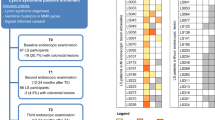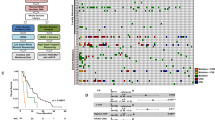Abstract
Microsatellite DNA alterations are an integral part of neoplastic progression and are valuable as clonal markers for the detection of human cancers1–3. Moreover, recent evidence suggests that senescent tumor cells may release DNA into the circulation, which is subsequently carried by and therefore enriched in the serum and plasma4,5. We tested 21 patients with primary head and neck squamous cell carcinoma (HNSCC) by polymerase chain reaction (PCR)–based microsatellite analysis of DNA from lymphocytes and paired serum samples. Patients were scored for alterations as defined by the presence of new alleles (shifts) or loss of heterozygosity (LOH) in serum at each of 12 markers and then compared with primary tumor DNA. Six out of 21 patients (29%) were found to have one or more microsatellite alterations in serum precisely matching those in the primary tumors. All six patients had advanced disease (stage III or IV); five of these patients had nodal metastases, three later developed distant metastases, and four died of disease. Microsatellite analysis of serum represents a novel method for the detection of circulating tumor cell DNA. If these results are confirmed in larger studies, microsatellite markers may be useful in assessing tumor burden in cancer patients.
This is a preview of subscription content, access via your institution
Access options
Subscribe to this journal
Receive 12 print issues and online access
$209.00 per year
only $17.42 per issue
Buy this article
- Purchase on Springer Link
- Instant access to full article PDF
Prices may be subject to local taxes which are calculated during checkout
Similar content being viewed by others
References
Mao, L. et al. Molecular detection of primary bladder cancer by microsatellite analysis. Science 271, 659–662 (1996).
Mao, L. et al. Microsatellite alterations as clonal markers for the detection of human cancer. Proc. Natl. Acad. Sci. USA 91, 9871–9875 (1994).
Merlo, A. et al. Frequent microsatellite instability in primary small cell lung cancer. Cancer Res. 54, 2098–2101 (1994).
Stroun, M. et al. Neoplastic characteristics of the DNA found in the plasma of cancer patients. Oncology 46, 318–322 (1989).
Stroun, M., Anker, P., Lyautey, J., Lederrey, C. & Maurice, P. Isolation and characterization of DNA from the plasma of cancer patients. Eur. J. Clin. Oncol. 23, 707–712 (1987).
Nawroz, H. et al. Allelotype of head and neck squamous cell carcinoma. Cancer Res. 54, 1152–1155 (1994).
Califano, J. et al. A genetic progression model for head and neck cancer: Implications for field cancerization. Cancer Res. 56, 2488–2492 (1996).
Shapiro, B. et al. Determination of circulating DNA levels in patients with benign or malignant gastrointestinal disease. Cancer 51, 2116–2120 (1983).
Leon, S.A. et al. Free DNA in the serum of cancer patients and the effect of therapy. Cancer Res. 37, 646–650 (1977).
Vasioukhin, V. et al. Point mutations of the N-ras gene in the blood plasma: DNA of patients with myelodysplastic syndrome or acute myelogenous leukaemia. Br. J. Haematol. 86, 774–779 (1994).
Vasioukhin, V. et al. K-ras point mutations in the blood plasma DNA of patients with colorectal tumors, in Challenges of Modern Medicine: Biotechnology Today, (eds. Verna, R. & Shamoo, A.) 141–150 (Ares-Serano Symposia Publications, Rome, 1994).
Sorenson, G.D. et al. Soluble normal and mutated DNA sequences from single-copy genes in human blood. Cancer Epidemiol. Biomark. Prev. 3, 67–71 (1994).
Chen, X.Q. et al. Microsatellite alterations in plasma DNA of small cell lung cancer patients. Nature Med. 2, 1034–1036 (1996).
Vokes, E.E., Weichselbaum, R.R., Lippman, S.M. & Hong, W.K. Head and neck cancer [review]. N. Engl. J. Med. 328, 184–194 (1993).
Brennan, J. J. etal. Molecular assessment of histopathological staging in squamous cell carcinoma of the head and neck. N. Engl J. Med. 332, 429–435 (1995).
Boyle, J.O. et al. The incidence of p53 mutations increases with progression of head and neck cancer. Cancer Res. 53, 4477–4480 (1993).
Van der Riet, P. . et al. Progression of basal cell carcinoma through loss of chromosome 9q and inactivation of single p53 allele. Cancer Res. 54, 25–27 (1994).
Sidransky, D. D. etal. Identification of p53 gene mutations in bladder cancers and urine samples. Science 252, 706–709 (1991).
Litt, M., Hauge, X. & Sharma, V. Shadow bands seen when typing polymorphic dinucleotide repeats: Some causes and cures. Biotechniques 15, 280–284 (1993).
Beahrs, O., Henson, D., Hutter, R. & Myers, M. M. eds. Manual for Staging of Cancer. 3rd edn. 27-62 (Lippincott, Philadelphia, 1988).
Author information
Authors and Affiliations
Rights and permissions
About this article
Cite this article
Nawroz, H., Koch, W., Anker, P. et al. Microsatellite alterations in serum DNA of head and neck cancer patients. Nat Med 2, 1035–1037 (1996). https://doi.org/10.1038/nm0996-1035
Received:
Accepted:
Issue Date:
DOI: https://doi.org/10.1038/nm0996-1035
This article is cited by
-
Therapeutically harnessing extracellular vesicles
Nature Reviews Drug Discovery (2022)
-
Stance of MRD in Non-Hodgkin’s Lymphoma and its upsurge in the novel era of cell-free DNA
Clinical and Translational Oncology (2021)
-
„Liquid biopsy“ als Schlüsselfigur in der Immunonkologie
HNO (2020)
-
Comparison of CDH1 Gene Hypermethylation Status in Blood and Serum among Gastric Cancer Patients
Pathology & Oncology Research (2020)
-
The interplay of circulating tumor DNA and chromatin modification, therapeutic resistance, and metastasis
Molecular Cancer (2019)



